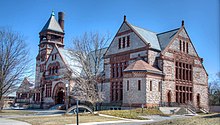 | |
| Director | Eric Peterson |
|---|---|
| Chairperson | Katherine Burton Jones |
| Owner | Metropolitan Waterworks Museum Inc. |
| Public transit access | Green Line (D branch)Reservoir |
| Website | waterworksmuseum |
| Interactive map highlighting the location of the museum | |
| Location | 2450 Beacon Street, Chestnut Hill, Massachusetts, US |
| Coordinates | 42°19′54.088″N 71°9′20.329″W / 42.33169111°N 71.15564694°W / 42.33169111; -71.15564694 |
| Architect | Arthur H. Vinal |
| Architectural style(s) | Richardsonian Romanesque |
|
U.S. Historic district Contributing property | |
| Official name | Chestnut Hill High Service Pumping Station |
| Designated | January 18, 1990 |
| Part of | Chestnut Hill Reservoir Historic District |
| Reference no. | 89002271 |
The Waterworks Museum is a museum in the Chestnut Hill Waterworks building, originally a high-service pumping station of the Boston Metropolitan Waterworks. It contains well-preserved mechanical engineering devices in a Richardsonian Romanesque building.
During its busiest years, the waterworks pumped as much as a hundred million gallons of water each day. The station was decommissioned in the 1970s, and later some of its buildings were turned into condominiums. After a period of disuse, the pumping station was restored, and in 2007 the Waterworks Preservation Trust was set up to oversee its conversion into a museum. In March 2011, the building reopened to the public as the Waterworks Museum.
History

In the 1850s, Boston began modernizing its water supply, which at the time was a combination of wells, pond water, and downhill piping from a Natick reservoir.
In the 1870s, Boston city leaders decided the city needed to scale up its water filtration and pumping and began looking into options.
In 1886, this 'high service' pumping station was designed, and the next year it came online as the Chestnut Hill pumping station - only a few years after the first such station in the world, in Germany. Water was pumped from this station uphill to the Fisher Hill reservoir, where gravity would then push the water to the surrounding area.
In 1894, the station put its third water pump into operation: a steam-powered water pump designed by Erasmus Darwin Leavitt. The Leavitt-Riedler Pumping Engine, as it was later called, was promoted as "the most efficient pumping engine in the world" it was first unveiled, and remained in operation through 1928. In the 20th century it was declared a historic mechanical engineering landmark by the American Society of Mechanical Engineers. It was fully restored by the museum and is the centerpiece of its main floor.
Trivia
Mark Wahlberg filmed part of his 1992 "You Gotta Believe" in the basement of the building.
The building contains the stonework faces of its designer, Arthur H. Vinal, and his wife.
Gallery
See also
References
- Burkett, Meisha Hunter (18 October 2019). "Silent and Unseen: Stewardship of Water Infrastructural Heritage". Adaptive Strategies for Water Heritage: 20–39. doi:10.1007/978-3-030-00268-8_2. ISBN 978-3-030-00267-1.
The former Metropolitan Waterworks' high-service pumping station in Boston (originated by Arthur Vinal, 1885–1887 and expanded by Edmund Wheelwright, 1897–98) was recently opened as the Waterworks Museum.
- Kempe, Marcis (June 2015). "The Metropolitan Waterworks Museum: Boston's Story of Water Works Villains, Heroes, and Machinery". American Water Works Association. 107 (6): 60–65. doi:10.5942/jawwa.2015.107.0090.
- ^ Olia, Maria (2019-05-01). No Access Boston: Beantown's Hidden Treasures, Haunts, and Forgotten Places. Rowman & Littlefield. ISBN 9781493035946.
- Beaulieu, Rebekah (2017). Financial Fundamentals for Historic House Museums. Lanham, Maryland: Rowman & Littlefield. p. 11 & 13. ISBN 9781538100325.
- Angelo, Dana (2007). "Waterworks Museum Project Proposal" (PDF).
- Rosenthal, Beryl (March 2013). "Metropolitan Waterworks Museum and Chestnut Hill Reservoir—Boston, Massachusetts". Journal of the New England Water Works Association. 127 (1): 66.
- De Witt, Dennis (2018). "The Metropolitan Waterworks Museum at Chestnut Hill pumping station, Boston, USA". Proceedings of the Institution of Civil Engineers - Engineering History and Heritage. 172 (3): 110–124. doi:10.1680/jenhh.18.00019. ISSN 1757-9430. S2CID 134814417.
- "Leavitt-Riedler Pumping Engine". www.asme.org. Retrieved 2019-12-01.
- "Waterworks Museum, 2450 Beacon St, Boston, MA (2019)". www.gluseum.com. Retrieved 2019-11-09.
- Moskow, Shirley (February 23, 2017). "Let your appreciation flow at the Waterworks Museum". Boston Globe.
Further reading
- Jackson, Daniel; Rosenthal, Linda (2011). Hilton, Margerie (ed.). Art and Architecture of the Metropolitan Waterworks. Boston: Metropolitan Waterworks Museum. ISBN 978-1463510381.
- Nesson, Fern Leicher (1983). Great Waters: A History of Boston's Water Supply. Boston: Brandeis University Press. ISBN 0874512239.
External links
- Official website

- Historic American Engineering Record (HAER) No. MA-24, "Boston Water Works, Chestnut Hill High-Service Pumping Station, 2450 Beacon Street, Boston, Suffolk County, MA", 5 photos, 1 color transparency, 3 data pages, 2 photo caption pages
- HAER No. MA-24-A, "Boston Water Works, Leavitt Pumping Engine", 3 photos, 5 data pages, 1 photo caption page
- HAER No. MA-24-B, "Boston Water Works, Worthington Pump", 3 photos, 1 data page, 1 photo caption page







